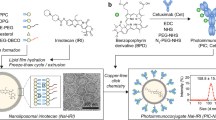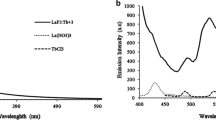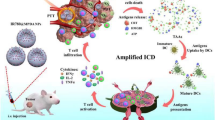Abstract
Objective
Targeted photodynamic therapy (PDT) is necessary for preventing the side effects associated with PDT, such as photosensitivity caused by the distribution of photosensitizers into normal tissues. In the development of targeted PDT agents, a simple evaluation system of in vivo pharmacokinetics, as well as target cell uptake, is absolutely imperative. We hypothesized that 64Cu chelation with porphyrin photosensitizer-biomacromolecule conjugates may become a simple and versatile labeling strategy for this purpose.
Methods
Protoporphyrin IX (PPIX) and a bombesin (BBN) analog, that interacts with the gastrin-released peptide (GRP) receptor, were used as a photosensitizer and tumor-targeting peptide, respectively. Then, a conjugate of PPIX and BBN analog linked via short polyethylene glycol (PPIX-PEG6-BBN analog) was synthesized and used as a targeted PDT agent. In addition, a 64Cu-chelated PPIX-PEG6-BBN analog was synthesized under optimized reaction conditions. Lastly, cell uptake study and PET image-based pharmacokinetic analyses of the PPIX-PEG6-BBN analog were carried out in a human prostate cancer cell line, PC-3, which highly expresses the GRP receptor, and PC-3 tumor-bearing mice.
Results
It was confirmed that degradation (thought to be based on radiolysis) occurs, and large amounts of 64Cu-labeling compounds are wasted in the reaction mixture. Interestingly, the addition of ethanol into the reaction mixture provides an effective solution for this problem. As for cell uptake study, the [64Cu]PPIX-PEG6-BBN analog demonstrated significantly higher uptake for PC-3 cells than [64Cu]PPIX and, in addition, the uptake of [64Cu]PPIX-PEG6-BBN analog was significantly inhibited by adding excess cold BBN analog peptide. PET image-based pharmacokinetic evaluation revealed that [64Cu]PPIX-PEG6-BBN analog and [64Cu]PPIX rapidly accumulate into the liver and kidney, circulate in blood for a long time compared with normal peptides, and distribute at a low level in the tumor. This result suggested that in vivo biodistribution of PPIX-PEG6-BBN analog is mainly dependent on the lipophilicity of PPIX. Ex vivo measurements of radioactivity distribution after PET studies showed that although there was no remarkable difference in the tumor/skin ratio of radioactivity between [64Cu]PPIX-PEG6-BBN analog and [64Cu]PPIX, the pancreas (an organ that also expresses GRP receptors)/skin ratio was significantly higher in the case of [64Cu]PPIX-PEG6-BBN analog.
Conclusion
We report on the successful synthesis of 64Cu-chelated porphyrin photosensitizers and their tumor-targeting peptide conjugates under conditions in which radiolysis is suppressed. This labeling strategy with porphyrin photosensitizers may be of value for the rapid development of ideal targeted PDT agents.











Similar content being viewed by others
References
Sternberg ED, Dolphin D, Bruckner C. Porphyrin-based photosensitizers for use in photodynamic therapy. Tetrahedron. 1998;54:4151–202.
Detty MR, Gibson SL, Wagner SJ. Current clinical and preclinical photosensitizers for use in photodynamic therapy. J Med Chem. 2004;47:3897–915.
Sharman WM, Allen CM, van Lier JE. Photodynamic therapeutics: basic principles and clinical applications. Drug Discov Today. 1999;4:507–17.
Dolmans DEJGJ, Fukumura D, Jain RK. Photodynamic therapy for cancer. Nat Rev Cancer. 2003;3:380–7.
Castano AP, Mroz P, Hamblin MR. Photodynamic therapy and anti-tumour immunity. Nat Rev Cancer. 2006;6:535–45.
Luketich JD, Christie NA, Buenaventura PO, Weigel TL, Keenan RJ, Nguyen NT. Endoscopic photodynamic therapy for obstructing esophageal cancer: 77 cases over a 2-year period. Surg Endosc. 2000;14:653–7.
Sharman WM, van Lier JE, Allen CM. Targeted photodynamic therapy via receptor mediated delivery systems. Adv Drug Deliv Rev. 2004;56:53–76.
Rahimipour S, Ben-Aroya N, Ziv K, Chen A, Fridkin M, Koch Y. Receptor-mediated targeting of a photosensitizer by its conjugation to gonadotropin-releasing hormone analogues. J Med Chem. 2003;46:3965–74.
Sibrian-Vazquez M, Jensen TJ, Hammer RP, Vicente MGH. Peptide-mediated cell transport of water soluble porphyrin conjugates. J Med Chem. 2006;49:1364–72.
Maina T, Nock BA, Zhang HW, Nikolopoulou A, Waser B, Reubi J, et al. Species differences of bombesin analog interactions with GRP-R define the choice of animal models in the development of GRP-R-targeting drugs. J Nucl Med. 2005;46:823–30.
Mummidi S, Bamshad M, Ahuja SS, Gonzalez E, Feuillet PM, Begum K, et al. Evolution of human and non-human primate CC chemokine receptor 5 gene and mRNA—potential roles for haplotype and mRNA diversity, differential haplotype-specific transcriptional activity, and altered transcription factor binding to polymorphic nucleotides in the pathogenesis of HIV-1 and Simian immunodeficiency virus. J Biol Chem. 2000;275:18946–61.
Sugiyama Y, Yamashita S. Impact of microdosing clinical study—why necessary and how useful? Adv Drug Deliv Rev. 2011;63:494–502.
Gupta N, Price PM, Aboagye EO. PET for in vivo pharmacokinetic and pharmacodynamic measurements. Eur J Cancer. 2002;38:2094–107.
Bergstrom M, Grahnen A, Langstrom B. Positron emission tomography microdosing: a new concept with application in tracer and early clinical drug development. Eur J Clin Pharmacol. 2003;59:357–66.
Takashima T, Yokoyama C, Mizuma H, Wada Y, Onoe K, Nagata H, et al. Developmental changes in P-glycoprotein function in the blood–brain barrier of nonhuman primates: PET study with R-(11)C-Verapamil and (11)C-Oseltamivir. J Nucl Med. 2011;52:950–7.
Yamashita S, Takashima T, Kataoka M, Oh H, Sakuma S, Takahashi M, et al. PET imaging of the gastrointestinal absorption of orally administered drugs in conscious and anesthetized rats. J Nucl Med. 2011;52:249–56.
Kavali RR, Lee BC, Moon BS, Yang SD, Chun KS, Choi CW, et al. Efficient methods for the synthesis of 5-(4-[F-18]fluorophenyl)-10,15,20-tris(3-methoxyphenyl)porphyrin as a potential imaging agent for tumor. J Label Compd Radiopharm. 2005;48:749–58.
Rothemund P, Menotti AR. Porphyrin studies; the metal complex salts of alpha, beta, gamma, delta-tetraphenylporphine. J Am Chem Soc. 1948;70:1808–12.
Fleischer EB, Choi EI, Hambright P, Stone A. Porphyrin studies: kinetics of metalloporphyrin formation. Inorg Chem. 1964;3:1284–7.
Moore CM, Pendse D, Emberton M. Photodynamic therapy for prostate cancer—a review of current status and future promise. Nat Rev Urol. 2009;6:18–30.
Zhang HW, Chen JH, Waldherr C, Hinni K, Waser B, Reubi JC, et al. Synthesis and evaluation of bombesin derivatives on the basis of pan-bombesin peptides labeled with indium-111, lutetium-177, and yttrium-90 for targeting bombesin receptor-expressing tumors. Cancer Res. 2004;64:6707–15.
Reile H, Armatis PE, Schally AV. Characterization of high-affinity receptors for bombesin/gastrin releasing peptide on the human prostate cancer cell lines PC-3 and DU-145: internalization of receptor bound 125I-(Tyr4) bombesin by tumor cells. Prostate. 1994;25:29–38.
McCarthy DW, Shefer RE, Klinkowstein RE, Bass LA, Margeneau WH, Cutler CS, et al. Efficient production of high specific activity Cu-64 using a biomedical cyclotron. Nucl Med Biol. 1997;24:35–43.
Chen XY, Park R, Tohme M, Shahinian AH, Bading JR, Conti PS. MicroPET and autoradiographic imaging of breast cancer alpha(v)-integrin expression using F-18- and Cu-64-labeled RGD peptide. Bioconjugate Chem. 2004;15:41–9.
Fournier P, Dumulon-Perreault V, Ait-Mohand S, Langlois R, Bénard F, Lecomte R, Guérin B. Comparative study of 64Cu/NOTA-[D-Tyr6, βAla11, Thi13, Nle14]BBN(6–14) monomer and dimers for prostate cancer PET imaging. EJNMMI Res. 2012;2:8.
Scott PJH, Hockley BG, Kung HF, Manchanda R, Zhang W, Kilbourn MR. Studies into radiolytic decomposition of fluorine-18 labeled radiopharmaceuticals for positron emission tomography. Appl Radiat Isot. 2009;67:88–94.
Boswell CA, Sun XK, Niu WJ, Weisman GR, Wong EH, Rheingold AL, et al. Comparative in vivo stability of copper-64-labeled cross-bridged and conventional tetraazamacrocyclic complexes. J Med Chem. 2004;47:1465–74.
Garrison JC, Rold TL, Sieckman GL, Figueroa SD, Volkert WA, Jurisson SS, et al. In vivo evaluation and small-animal PET/CT of a prostate cancer mouse model using Cu-64 bombesin analogs: side-by-side comparison of the CB-TE2A and DOTA chelation systems. J Nucl Med. 2007;48:1327–37.
Ogata Y, Kosugi Y, Morimoto T. Kinetics of the cupric salt-catalysed autoxidation of L-ascorbic acid in aqueous solutions. Tetrahedron. 1968;24:4057–66.
Li Q, Wei W, Liu Q. Indirect determination of thiocyanate with ammonium sulfate and ethanol by extraction-flotation of copper. Analyst. 2000;125:1885–8.
Funahashi S, Inada Y, Inamo M. Dynamic study of metal-ion incorporation into porphyrins based on the dynamic characterization of metal ions and on sitting-atop complex formation. Anal Sci. 2001;17:917–27.
Bases R, Brodie SS, Rubenfeld S. Attempts at tumor localization using Cu 64-labeled copper porphyrins. Cancer. 1958;11:259–63.
Soucy-Faulkner A, Rousseau JA, Langlois R, Berard V, Lecomte R, Benard F, et al. Copper-64 labeled sulfophthalocyanines for positron emission tomography (PET) imaging in tumor-bearing rats. J Porphyr Phthalocyanines. 2008;12:49–53.
Kumar M, Neta P, Sutter TPG, Hambright P. One-electron reduction and demetallation of copper porphyrins. J Phys Chem. 1992;96:9571–5.
Grodkowski J, Neta P, Hambright P. Radiolytic reduction of rhodium porphyrins. Chain reaction in alkaline 2-propanol. J Phys Chem. 1995;99:6019–23.
Serdons K, Verbruggen A, Bormans GM. Developing new molecular imaging probes for PET. Methods. 2009;48:104–11.
Wadas TJ, Wong EH, Weisman GR, Anderson CJ. Coordinating radiometals of copper, gallium, indium, yttrium, and zirconium for PET and SPECT imaging of disease. Chem Rev. 2010;110:2858–902.
Berg K, Bommerb JC, Moan J. Evaluation of sulfonated aluminum phthalocyanines for use in photochemotherapy. Cellular uptake studies. Cancer Lett. 1989;44:7–15.
Lin JH, Lu AYH. Role of pharmacokinetics and metabolism in drug discovery and development. Pharmacol Rev. 1997;49:403–49.
Sancho V, Florio AD, Moody TW, Jensen RT. Bombesin receptor-mediated imaging and cytotoxicity: review and current status. Curr Drug Deliv. 2011;8:79–134.
Acknowledgments
This work was supported, in part, by a consignment expense for the Molecular Imaging Program entitled “Research Base for Exploring New Drugs” from the Ministry of Education, Culture, Sports, Science and Technology (MEXT) of Japan. We would like to thank Mr. M. Kurahashi (Sumitomo Heavy Industry Accelerator Service Ltd.) for operating the cyclotron, Dr. K. Takahashi, Dr. Y. Kanayama and Ms. R. Zochi (RIKEN) for supporting 64Cu production, Ms. E. Hayashinaka (RIKEN) for supporting the reconstruction of PET images, and the RIKEN Biomolecular Characterization Team for supporting the MALDI-TOF–MS analysis. The authors declare that they have no financial interests in this study.
Author information
Authors and Affiliations
Corresponding author
Rights and permissions
About this article
Cite this article
Mukai, H., Wada, Y. & Watanabe, Y. The synthesis of 64Cu-chelated porphyrin photosensitizers and their tumor-targeting peptide conjugates for the evaluation of target cell uptake and PET image-based pharmacokinetics of targeted photodynamic therapy agents. Ann Nucl Med 27, 625–639 (2013). https://doi.org/10.1007/s12149-013-0728-2
Received:
Accepted:
Published:
Issue Date:
DOI: https://doi.org/10.1007/s12149-013-0728-2




